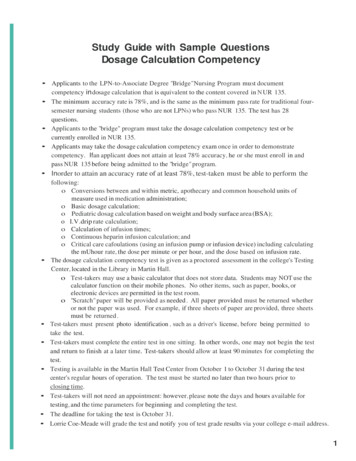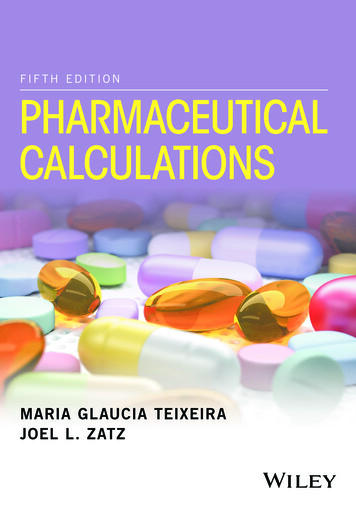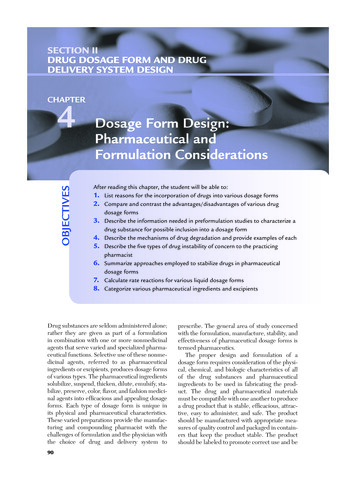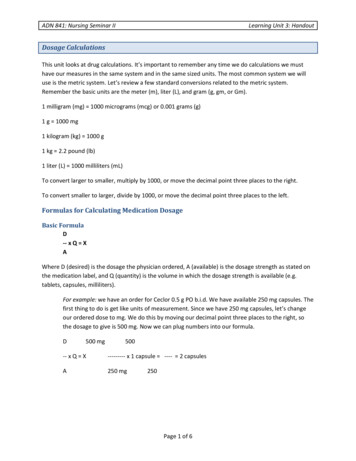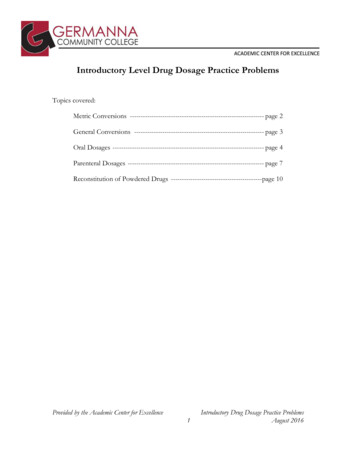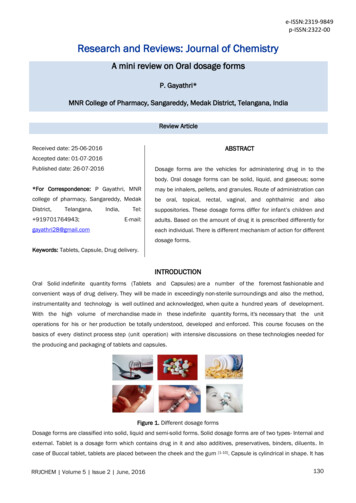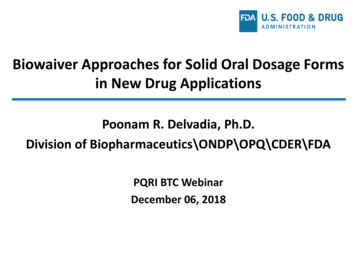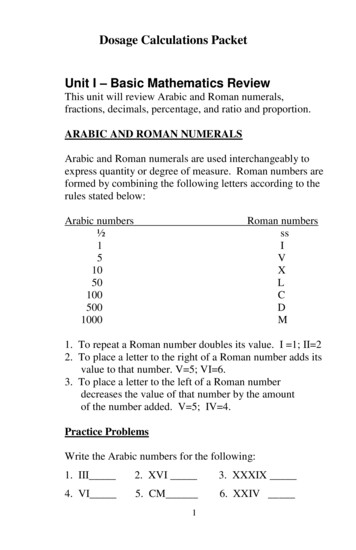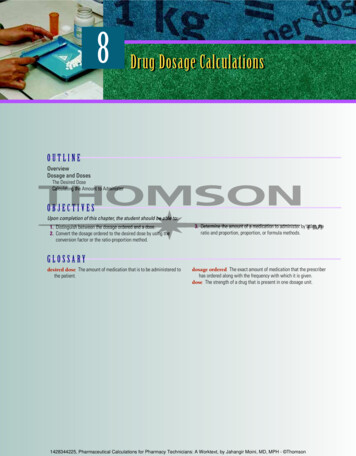
Transcription
8Drug Dosage CalculationsOUTLINEOverviewDosage and DosesThe Desired DoseCalculating the Amount to AdministerOBJECTIVESUpon completion of this chapter, the student should be able to:1. Distinguish between the dosage ordered and a dose.2. Convert the dosage ordered to the desired dose by using theconversion factor or the ratio-proportion method.3. Determine the amount of a medication to administer by using theratio and proportion, proportion, or formula methods.GLOSSARYdesired dose The amount of medication that is to be administered tothe patient.dosage ordered The exact amount of medication that the prescriberhas ordered along with the frequency with which it is given.dose The strength of a drug that is present in one dosage unit.1428344225, Pharmaceutical Calculations for Pharmacy Technicians: A Worktext, by Jahangir Moini, MD, MPH - Thomson
72CHAPTER 8 Drug Dosage CalculationsOVERVIEWThe ability to calculate drug dosages is a skill that shouldnot be taken lightly. In fact, the pharmacy technicians whodeal with dispensing and preparing medications shouldaim for 100% success in performing this task.When a technician receives an order for a medicationin a dosage that is different from that of the medications instock, he must be able to use his skill to accurately calculate by using formulas, mathematical tables, or calculators.Learning to correctly calculate drug dosages is an extremely important skill, because it can often be the difference between life and death for a patient.DOSAGE AND DOSESThe dosage ordered is the exact amount of medicationthat the prescriber has ordered along with the frequencywithh which it is given.iven. This informationinf mation may be foundund onthe prescriptionscripor through a verbalerbal order by theth physician. A dosdose is thee strength of a drugrug that is presentprese t in onedosage unit; this is generally the amount of drug that thepharmacy has on hand to prepare the dosage ordered.redWhenhen a pharmacy technician receives a physician’s order,the dosage and dose of the medication mustt be identified.For example, review the following information on how todetermine the dosage ordered and the dose on hand:Order:Supply:Lopid 0.6 g p.o. b.i.d.Lopid 600 mg tabletsIn this example, the dosage is 0.6 g. The dose on hand is600 mg (as determined from the drug label).These two lead to the same result. When a physician orders a medication wherein the amount of drug orderedequals the amount given to the patient, the ratio will beequal to 1.Dosage ordered desired doseTherefore,dosage ordered 1desired doseEXAMPLE:The dosage ordered:15 mgThe desired dose:15 mg 115 mg15 mgThe Conversion Factor MethodWhen thee desired dosedis unknown,unknown usese the conversionconversfactor fformula.rmula.EXAMPLE:The dosage ordered is 0.5 mg.The dose on hand is in mcg.You want to find the desired dose.dosage ordered0.5 mg Xdesired dose0.5 mg conversion factorXThe conversion factor should relate mg to mcg.You know that 1 mg 1000 mcg, therefore:1 mg1000 mcg0.5 mg1 mg X1000 mcgIf you cross multiply, you arrive at the result of:0.5 1000 X 1X 0.5 * 1000 1X 0.5000 500 mcg哭(Courtesy of Parke-Davis)The Desired DoseTo calculate the desired dose (the amount of medicationto be administered to the patient), one of two methods canbe used. One is the conversion factor method by usingfraction proportion. Another is the ratio and proportion.The Ratio and Proportion MethodRatio and proportion form the basis for nearly all calculation and is a concept that seems to be generally understood and used. However, many pharmacy technicianshave difficulty in problem interpretation and identifying aplace to start. Recall from Chapter 3 that a ratio states therelation of one quantity to another and may be written as1428344225, Pharmaceutical Calculations for Pharmacy Technicians: A Worktext, by Jahangir Moini, MD, MPH - Thomson
CHAPTER 8 Drug Dosage Calculationsa common fraction (implying division) or with a colon between the two numbers. For example, three parts compared with four parts is written as “3/4,” “3 : 4,” or “threeis to four.”Two equal ratios that are set equal to each other resultin an equation called a proportion. For example,315 4203 : 4 : : 15 : 20The first and last terms of a proportion are called the extremes, and the second and third terms are called themeans.3:4::15 : 20meansextremesEXAMPLEXAMPLE 1:If 100 g of a ddrugg costs 2.60, hhoww much will25 g cost?100 g : 25 g : : 2.60 : X25 g * 2.60X 100 gX 65 00.65100EXAMPLE 2: Ordered:Biaxin 0.5 g p.o. q8hOn hand:Biaxin 250 mgDesired dose XRemember To find the desired dose:Use the conversion factor formulaUse the ration and proportion methodSTOP ANDREVIEWCalculating the Desired Dose1. Ordered:On hand:Desired dose:Synthroid 0.05 mgSynthroid 50 mcg tablets2. Ordered:On hand:Desired dose:Aspirin gr v p.o. q.d.Aspirin 325 mg tablets3. Ordered:On hand:Desired dose:Levoxyl 0.15 mgLevoxyl 300 mcg tablets4. Ordered:On hand:Desired dose:Phenobarbital gr 1/2 p.o. q.d.Phenobarbital 15 mg5. Ordered:On hand:Desired dose:Duricef 0.75 g p.o. q.i.d. a.c.Duricef 500 mg per tablet6. Ordered:On hand:Desired dose:Ampicillin 0.25 gAmpicillin 125 mg capsules(continues)(Courtesy of Abbott Laboratories)250 mg : 1 tab : : 500 mg : X tab250 X 500X 73500 2 tablets2501428344225, Pharmaceutical Calculations for Pharmacy Technicians: A Worktext, by Jahangir Moini, MD, MPH - Thomson
74CHAPTER 8 Drug Dosage CalculationsIn this example, you need to give a patient 500mg of medication, but you do not know how(continued)7. Ordered:On hand:Desired dose:Codeine sulfate gr 3/4 p.o. q4h p.r.n.,painCodeine sulfate 30 mg per 1 mL8. Ordered:On hand:Desired dose:digoxin elixir 0.25 mg p.o. q.d.digoxin elixir 50 mcg / mL9. Ordered:Nitrostat gr 1/400 SL p.r.n., for anginapainNitrostat 0.3 mgOn hand:Desired dose:10. Ordered:On hand:Desired dose:V-Cillin K 0.5 g p.o. q.i.d.V-Cillin K 250 mg per tabletmany capsules to administer. Using a fractionproportion, write:250 mg500 mg X1 capsuleCross multiply to find the number of capsules toadminister.250 X 1 500X 500 2 capsules250STOP ANDREVIEWThe Proportion MethodCalculatinglculating ththee Amount to AdministerWhen calculatingalcuthe desired dose,dose, it is also necessarynec ssary tocalculate ththe amountt tot administerd ito the patient.patForF example, how many tablets should be given to the patient,or how much volume of solutionution must be drawn into a syringege or mixed into an intravenous solution bag. To calculate the amount to administer, the ratio and proportioni(already discussed above), or a formula can be used,which all provide the same result.Two important pieces of information, the dosage unitand the dose on hand, come from knowing the dosagestrength on a drug label. You have already learned to calculate a third piece of information, the desired dose. Youcan calculate a fourth piece of information, the amount toadminister, by using this information.The Proportion MethodIn this method, it is important to remember that thedosage strength of a drug does not change based on theamount to be administered. If you administer 250 mg of amedication in one capsule, you can give 500 mg in twocapsules because the dosage strength remains 250 mg percapsule.1. Ordered:On hand:Give:Covera-HS 480 mg p.o. b.i.d.Covera-HS 240 mg tablets2. Ordered:Ilosone Liquid (erythromycin) 0.5 g to p.o.q.i.d.Ilosone 250 mg per 5 mLOn hand:Give:3. Ordered:On hand:Give:4. Ordered:On hand:Give:Heparin sodium 850 units by injectionHeparin sodium 1000 units per mL(multidose)Naloxone hydrochloride 0.3 mg by injectionNaloxone HCl injection 0.4 mg per mL(multidose)5. Ordered:On hand:Give:Epogen 1400 U by injectionEpogen 2000 units per mL6. Ordered:On hand:Give:Amoxil 250 mg p.o. t.i.d.Amoxil 250 mg per 5 mL7. Ordered:On hand:Give:Lopid 0.6 g p.o. b.i.d.Lopid 600 mg tablets8. Ordered:On hand:Clindamycin 0.6 g IV q12hCleocin phosphate (Clindamycin injection)300 mg / 2 mLEXAMPLE:Use the proportion:250 mg500 mg 1 capsule2 capsulesGive:In other words, write this proportion in thegeneral formula as follows:desired dosedose on hand dosage unitamount to administer9. Ordered:On hand:Give:Ritalin 15 mg p.o. q.d.Ritalin 10 mg tablets1428344225, Pharmaceutical Calculations for Pharmacy Technicians: A Worktext, by Jahangir Moini, MD, MPH - Thomson
CHAPTER 8 Drug Dosage Calculations10. Ordered:On hand:Give:Lorabid 400 mg p.o. b.i.d.Lorabid 200 mg powder for suspension per5 mL75EXAMPLE 2:Find the amount to administer.Ordered:heparin 6000 U S.C. q12hOn hand:heparin 10,000 U / mL vialDesired dose is 6,000 U.The dosage unit (Q) is 1 mL.The Formula MethodThe formula method can also be used to determine theamount of medication to administer. The pharmacy technician must ensure that the medication information is inthe correct place within the formula. This formula can beused for most drug orders and it is useful to remember.The first step in computing medication dosage, regardless of the method used, is to make certain that thestrength of the drug ordered and the strength of the drugavailable are in the same unit of measure. If necessary,conversion to a single unit must be carried out.Once conversion to a single unit has been done, theproblem can be set uppp using the formula:D* Q XHD is the desired dose or ordered dosage.H is the dose on hand.Q is the dosage unit or quantity on hand.handX is the amount to administer.The answer, or the unknown, most commonly is signifiedby the letter X and is usually placed on the right side of theformula, preceded by an equal sign. The fraction proportion that was discussed before includes:dose on handdesired dose dosage unitamount to administerHD QXIf you cross multiply, HA DQorX D *Solve for X:6000 U * 1 mL X10,000 U6 U * 1 mL X10 U3U 0.6 mL5The amount to administer is 0.6 mL.Remember To calculate the amount of medication to administer, useone of the following:The ratio and proportion methodThe proportion methodThe formula methoddesired doseDose on hand Dosage unitamount to administerSTOP ANDREVIEWThe Formula MethodQHEXAMPLE 1:Ordered:6000 U * 1 mLD * Q X SH10,000 mL vialLasix 10 mg p.o. b.i.d.On hand:Lasix 20 mg per tablet10 mgD * QX * 1 tabletH20 mg10 mg11* 1 tablet * 1 tablet tablet20 mg22The amount to administer is 1/2 tablet.Therefore, you want to give 1/2 tablet of Lasix20 mg tablets orally twice daily.1. Ordered:On hand:Give:nitroglycerin 0.6 mg SLNitrostat 0.3 mg tablets2. Ordered:On hand:Give:phenobarbital 3/4 gr p.o.phenobarbital 15 mg tablets3. Ordered:On hand:Give:Ergotrate Maleate 200 mcg by injectionErgotrate Maleate 0.2 mg per 1 mL4. Ordered:On hand:Give:Cloxacillin 500 mg p.o. t.i.d.Cloxacillin 125 mg per 5 mL(continues)1428344225, Pharmaceutical Calculations for Pharmacy Technicians: A Worktext, by Jahangir Moini, MD, MPH - Thomson
76CHAPTER 8 Drug Dosage Calculations(continued)5. Ordered:On hand:Give:Humulin R Insulin 35 U SCHumulin R Insulin 100 units per mL8. Ordered:On hand:Give:Thorazine 15 mg IM statThorazine 25 mg per mL6. Ordered:On hand:Give:Decadron 5 mg IMDecadron 4 mg/mL (multidose vial)9. Ordered:On hand:Give:Codeine gr 1/4 q6h p.r.n., severe coughCodeine 30 mg tablets7. Ordered:On hand:Give:furosemide 80 mg p.o. nowLasix (furosemide) 40 mg tablets10. Ordered:On hand:Give:Lorabid oral suspension 150 mg p.o. b.i.d.Lorabid oral suspension 100 mg per 5 mLTEST YOUR KNOWLEDGECalculate the desired dose and then calculate theamount to administer in the following exercises.1. Ordered: Valium 3 mg IV statOn hand: Valium 10 mg/2 mLAmount to administer:2. Ordered: Dilantin 25 mg IV q8hOn hand: Dilantin 100 mg/2 mL ampuleAmount to administer:3. Ordered: ciprofloxacin 500 mg p.o. q12hOn hand: ciprofloxacin 250 mg tabletsAmount to administer:6. Ordered: sulfisoxazole (Gantrisin) 1g q.d.On hand: sulfisoxazole (Gantrisin) 250 mg per tabletAmount to administer:7. Ordered: mexiletine (Mexitil) 300 mg q8hOn hand: mexiletine (Mexitil) 150 mg per tabletAmount to administer:8. Ordered: Prilosec-Dr 20 mg p.o. q.d.On hand: Prilosec-Dr 10 mg capsulesAmount to administer:Use the labels below to calculate one dose of thefollowing orders.4. Ordered: Lanoxin 0.125 mg p.o. q.i.d.On hand: Lanox in 0.25 mg tabletsAmount to administer:9. Ordered: Zyloprim 0.25g p.o. b.i.d.On hand: Zyloprim 100 mg scored tabletsLabel: Amount to administer:5. Ordered: Diabinese 0.1g p.o. q.d.On hand: Diabinese 100 mg tabletsAmount to administer:10. Ordered: Vistaril 10 mg p.o. q.i.d.On hand: Vistaril 25 mg per 5 mLLabel: Amount to administer:(Label reproduced with permission of Pfizer Inc.)1428344225, Pharmaceutical Calculations for Pharmacy Technicians: A Worktext, by Jahangir Moini, MD, MPH - Thomson
CHAPTER 8 Drug Dosage CalculationsCRITICAL THINKINGUse the following label to answer these questions.(Courtesy of Abbott Laboratories)1. A physician’s order reads: Biaxin 150 mg p.o. b.i.d.Calculate the amount to administer.2. In some cases, the patient may receive 400 mg oncea day. Calculate the amount to administer for this dose.1428344225, Pharmaceutical Calculations for Pharmacy Technicians: A Worktext, by Jahangir Moini, MD, MPH - Thomson77
pharmacy has on hand to prepare the dosage ordered. When a pharmacy technician receives a physician's order, the dosage and dose of the medication must be identified. For example, review the following information on how to determine the dosage ordered and the dose on hand: Order: Lopid 0.6 g p.o. b.i.d. Supply: Lopid 600 mg tablets
